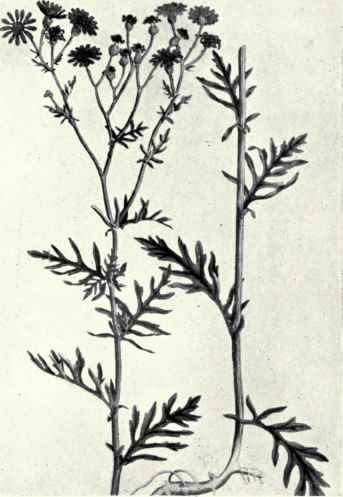Hoary Ragwort (Senecio Erucifolius, L.)
Description
This section is from the book "British Wild Flowers - In Their Natural Haunts Vol2-4", by A. R. Horwood. Also available from Amazon: A British Wild Flowers In Their Natural Haunts.
Hoary Ragwort (Senecio Erucifolius, L.)
This species is found in the North Temperate Zone to-day to the South of Gothland, and in N. and W. Asia. In Great Britain it is found in the Peninsula, Channel, Thames, Anglia, and Severn provinces; in Wales it is found in Glamorgan, Pembroke, Carnarvon, Denbigh, Flint, Anglesea, and in the Trent, Mersey, Humber, Tyne provinces, and in Cumberland, Lanark, Ayr, and Berwick. The Hoary Ragwort occurs in E. Ireland and the Channel Islands. It is common in S. Britain, but very rare in Scotland.
Hoary Ragwort is a familiar wild flower of the roadside, where it is accompanied by such plants as Knapweed, Nipplewort, Wild Basil, and the many other plants of the wayside, which grow there in a state of protection, and are not so liable to be browsed as in fields, where they likewise grow.
This is a taller plant than Groundsel, and the stem is rigid, simple or branched, purple, and woolly. The stem is both angular and furrowed. The leaves are alternate, much divided, with linear segments, half-clasping, with stiff hairs below, or white, the lower leaves stalked, turned back.
The flowers are rayed, in corymbose heads. The leaf-like organs are membranous at the margin with hairy tips, the outer half as long as the inner. The fruit is silky with hairs that do not fall out. The hoary character by which it is partly distinguished is most marked when the plants are young, and in wooded and hilly stations, a feature which in moist soil is lost, as also when it is cultivated.
This plant is about 2 ft. in height as a general rule. The flowers are in bloom in July and August. The plants are propagated by division, being perennial.
The ray florets are large and give the plant a conspicuous appearance. Otherwise the arrangements are as in Senecio vulgaris, though the heads are much larger, and the plant is more likely to be visited by insects.
The fruits are provided with pappus, and adapted for wind dispersal.
This Composite is mainly a sand-preferring species addicted to a sandy soil, but may also be found on clay soil.
The fungi Bremia lactucce and Colesporium senecionis are found upon the leaves. The Lepidoptera, the Feathered Ranunculus (Ep-unda lichenea), Cinnabar (Euchelia jacobece), Argyrolepia rugosana, Calosetia nigromaculana, and a fly, Spilographa zoe, feed on it.

Photo. \V. E. Mayes - Hoary Ragwort (senecio Erucifolius, L.)
Senecio is a Latin name for the Groundsel, a congener, from its resemblance to a bald head (senex, an old man). The second Latin name means hoary-leaved.
Essential Specific Characters: 166. Senecio erucifolius, L. - Stem tall, erect, hoary, purple, leaves pinnatifid, segments linear, downy beneath, margin revolute, flower-heads yellow, ray florets large, in dense corymb, ribs of fruit silky.
Continue to:


